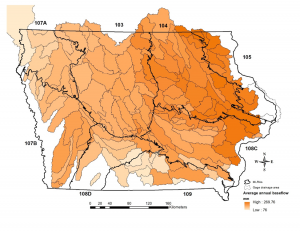Keith Schilling, IGS Director and State Geologist
During drought periods, like we are experiencing in 2021, everyone is keenly aware that the grass is brown and the soils are dry and cracking. Everyone knows that what we are missing is rainfall, enough to water our grass and flowers and keep the crops healthy. What you may not realize is that we also need rainfall to recharge our shallow groundwater supplies. You see, groundwater can be just as vulnerable to drought as your lawn.
When precipitation falls on the land surface, some of it runs off to the nearby stream, but some of it soaks into the ground in a process known as infiltration. The infiltrating water fills soil pores and drains downward through the profile until it enters the saturated zone at the water table. The water table marks the level below ground where 100% of the soil pores are filled with water. When water from the unsaturated zone enters the water table, the top of the water table raises up and “groundwater recharge” occurs.

Once water enters the groundwater system, it largely stays put and only very slowly travels to low areas where it seeps into streams, wetlands and lakes. Some shallow groundwater is pulled up by vegetation roots and discharged back to the atmosphere by plant transpiration and some groundwater may seep deeper into lower strata (Figure 1).
When soils and geologic deposits are permeable enough, like along major river corridors, shallow groundwater is pumped out of the ground for water supply and irrigation. Many public water supply systems in western and central Iowa use these shallow alluvial groundwater sources for their water supply.
So what happens during drought? Rainfall is substantially less, less water soaks into the ground, and less infiltrating water recharges the aquifers, and water levels go down. When water levels in shallow aquifers get lower, there is less groundwater available to pump and less water available to water your lawn or livestock. Think about recharge like your checking account at home. When your account is “recharged” by a paycheck, the availability of your money increases. When you make house and car payments, go out to eat or buy a larger TV, money in your account decreases but you count on your next paycheck to replenish your available funds. However, should you lose a job, there is no paycheck, ongoing expenses continue to deplete your account and pretty soon you’re broke. The only way to get back on your feet is a job, or in the case of groundwater levels, more rainfall recharge.

In new research at IGS led by me, with contributions from IGS geologist Rick Langel, Iowa DNR GIS analyst Calvin Wolter and IIHR research engineer, Antonio Arenas (now faculty at Iowa State), we quantified annual groundwater recharge in Iowa. In our study, we estimated recharge by assuming that the amount of groundwater discharging to rivers as baseflow is approximately equal to the amount of recharge entering the water table. Assuming that little groundwater is removed via pumping or discharged to lower strata (pretty good assumption in many areas of Iowa based on our layered glacial deposits), we quantified this baseflow “recharge” at 132 USGS stream gauging locations in the state. When we interpolated the distribution of the baseflow across the state, annual groundwater recharge in Iowa averaged approximately 8.7 inches in any given year (Figure 2).
Comparing this value of annual recharge to average annual rainfall we found that 25% of rainfall enters the water table as groundwater recharge every year. Recharge was found to be particularly concentrated in the months of May and June which accounted for about two-thirds of the annual amount.
Again, so what happens during drought? During a severe drought year (like 2012) the state receives only about 2-3 inches of groundwater recharge. When this occurs, there are consequences for water supply providers, river enthusiasts and, of course, agriculture. When annual recharge is less than about 3 inches, the agricultural industry in Iowa is severely impacted, and insurance payments to farmers can total nearly two billion dollars like it did in 2012. So, if we see statewide groundwater recharge trending toward a total annual amount less than approximately 3 inches, we can be certain that there will be economic consequences for agricultural yields that trigger large federal government crop insurance payments.
Clearly, drought is an issue that affects all Iowans and understanding the consequences of drought on groundwater recharge will be important during an uncertain climate future.
For more reading:
Schilling, K.E., R.J. Langel, C.F. Wolter and A. Arenas-Amado. 2021. Using baseflow to quantify diffuse groundwater recharge and drought at a regional scale. Journal of Hydrology, 602:126765.